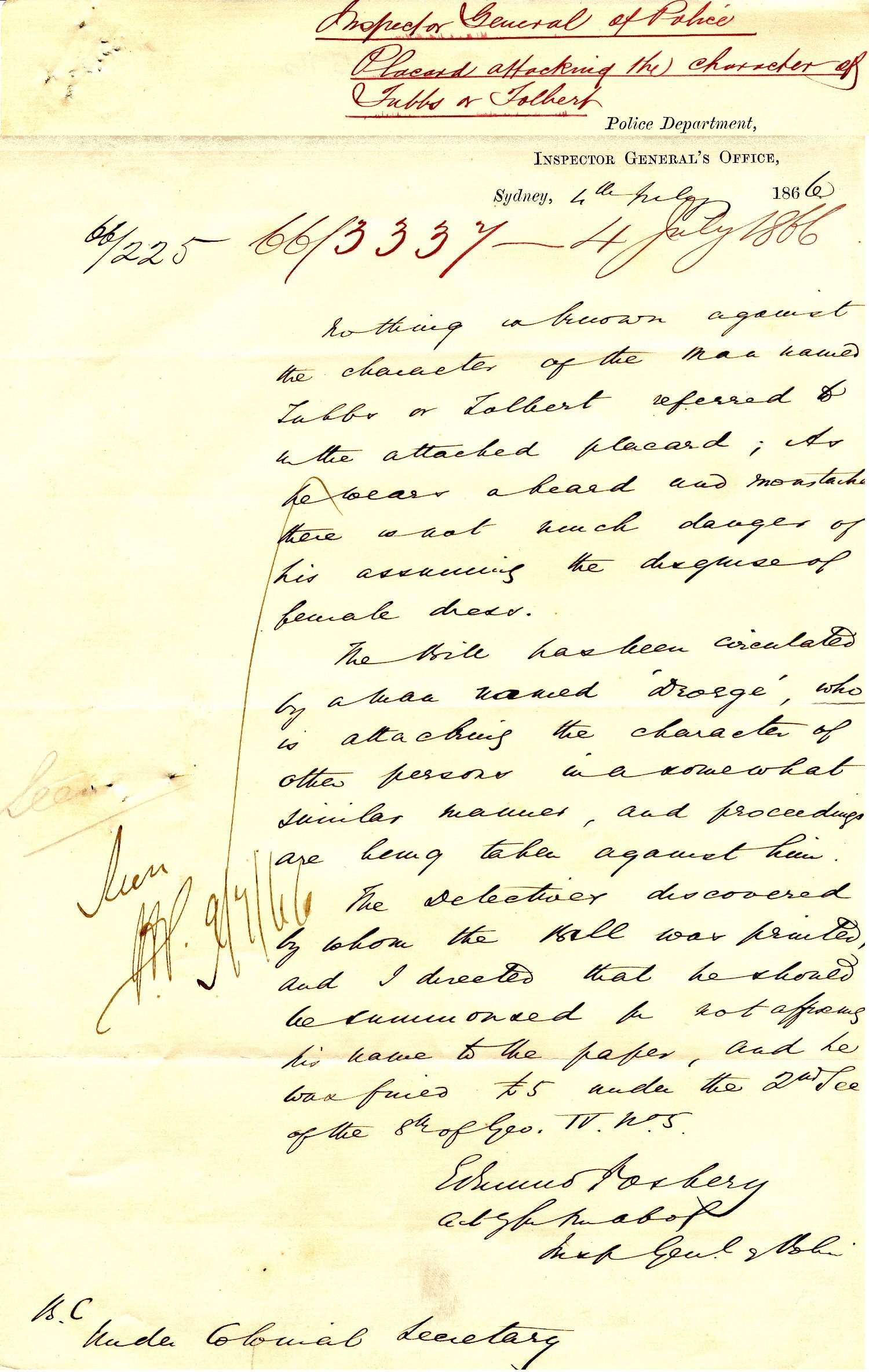Richard Gore is the Manager, Archives Control at State Records. This is his Staff Pick.
As the custodians of the oldest collection of official records in the country, we at State Records are rightly proud of the many significant documents and groups of records we hold, including the ‘world heritage’ archives of the convict system, the Charters of Justice of 1787 and 1823, and the extensive documentation of ‘iconic’ structures such as the Sydney Harbour Bridge and the Sydney Opera House.
However, my ‘staff pick’ is anything but significant or iconic. This small group of documents shows how a relatively trivial incident came to the attention of the Colonial authorities in late June/early July 1866, and how it was promptly dealt with. The papers were duly filed by a clerk of the Colonial Secretary’s Office, and there they remained undisturbed for 120 years.
They could easily have remained ‘undiscovered’ for another hundred years; however a researcher or staff member had stumbled across them by the mid 1980s (when looking for something else), and they were bought to my attention at the time I was selecting items from the collection for an exhibition to mark the 1988 Bicentenary. We were looking to showcase the richness and diversity of the collection, including in those areas where the State becomes involved with the seamier or even tragic aspects of day-to-day life. With more than enough material documenting murder, mayhem and neglected children, we were looking for items to provide some light relief, and this fitted the bill perfectly.
Annotation on Reverse side of Placard - This paper was thrust under my door in Wynyard Square Send it to Inspector General & enquire what it means HP 26/6/66
There is much to like about this quirky little bundle, although we know very little about the eccentric Mr Droege. In distributing placards with false or even libellous accusations he was certainly attacking the character of the persons named, as well as possibly offending the sensibilities of other law-abiding citizens. He may have harboured some grievances (real or imagined), or was perhaps not in the best of mental health at the time. It is interesting to note that the annotation on the reverse of the placard … ‘This paper was thrust under my door…’ is initialled ‘HP’. This is none other than Henry Parkes, who was the Colonial Secretary at the time.
Covering letter enclosing Placard - .......The enclosed is forwarded to the Inspector Genl. of Police, who will perhaps be able to report what it means.......
I also particularly like the report from the Inspector-General of Police, noting that ‘As he [Tubbs/Tolbert] wears a beard and moustache there is not much danger of his assuming the disguise of female dress’. This displays the dry sense of humour and world-weary tone of an official who has seen it all.

Response to investigation of placard - ...........Nothing is known against the character of the man named tubbs or tolbert referred to in the attached placard; As he wears a beard and moustache there is not much danger of his assuming the disguise of female dress. The Bill has been circulated by a man named 'Droege' who is attacking the character of other persons in a somewhat similar manner, and proceedings are being taken against him. The Detectives discovered by whom the Bill was printed, and I directed that he should be summonsed fr not affixing his name to the paper, and he was fined 5 under the 2nd Sec of GeoIV. No. 5.
Apart from the interesting glimpse of Sydney life that they illustrate, these documents also reveal the high quality of recordkeeping in the most important government department of the day. The subject matter may have been trivial, but all key documents were registered and indexed, the Colonial Secretary himself recorded how the placard was received, and a report was requested from the Police. When that office advised that it had effectively dealt with the matter, all the papers were appropriately filed within the exemplary system of registered correspondence maintained by the office of the Colonial Secretary. ‘Full and accurate’ recordkeeping indeed!
Richard Gore
—————————————————————————————–
The ‘Colonial Secretary’s Papers’ is the most comprehensive surviving collection of public records relating to the early years of European settlement in Australia and one of the most useful resources for anyone studying the formative years of the Colony of NSW.
The Papers include:
- petitions by convicts for mitigation of their sentences;
- requests for permission to marry;
- memorials attesting to the worthy character of potential settlers;
- applications for land grants or leases;
- reports on official visits;
- information about court cases and lists of assigned servants
– in fact anything to do with the colonial administration of the day.
There is an online index to the Colonial Secretary’s Papers, 1788-1825 which is arranged alphabetically by surname and subject and provides ready access to the wealth of information contained in the important records. Indexes to the later years are available on microfiche in the reading rooms.

Lis says:
What a wonderful find and a grand explanation from Richard Gore.
Many thanks for your article.
Richard Gore says:
Thanks for the feedback. These documents are a good example of the richness and diversity of the archives, which can give a glimpse of unusual happenings on the streets of Sydney, as well as documenting important matters of policy and administration.
For more detail on Sydney’s colourful criminal underworld (in the 1840s) see the Registry of Flash Men (digitised copy and full transcription) at
http://srwww.records.nsw.gov.au/ebook/flashmen.asp
Michelle says:
Shows that everything new has been seen before…great little find.
Penny says:
Thanks for sharing a very interesting article.
Chrissy says:
Richard, thank you so much for a great read.